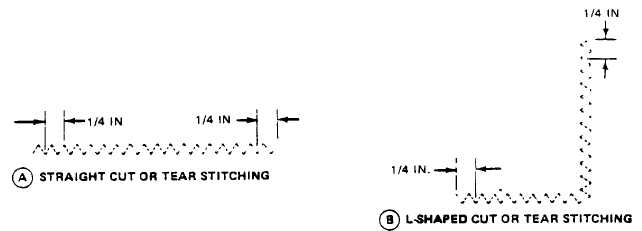ARMY TM 10-1670-271-23&P
AIR FORCE TO 14D1-2-464-2
MARINE CORPS TM 01136B-23&P/1
(2) Beginning at a point 1/4 inch beyond one end of the cut or tear, stitch lengthwise along the damaged
area to a point 1/4 inch beyond the opposite end of the cut or tear (A, figure 2-74). The cited
stitching procedure will also apply to an L-shaped cut or tear (B, figure 2-74).
Figure 2-74. Repair Method Using a Zig-Zag Sewing Machine.
(3) If applicable, restencil informational data or identification marks as prescribed in paragraph 2-19.
e. Patching. Patching is a procedure used to repair holes which cannot be darned.
(1) Parachute canopy patching limitations. The following is a list of patching limitations for the T-10B
parachute assembly.
WARNING
The limitations prescribed for parachute canopy patching will be stringently
adhered to under all circumstances and without any deviations.
(a) A patch will not be applied to a damaged area that has been previously patched.
(b) There is no limitation to the number of patches or size of patch to each canopy gore section
or gore panel. However, determination should be made as to the most economical method
to be used, i.e., two or more patches versus one large patch or one large patch versus a
section replacement. A patch applied to a parachute canopy may extend from radial seam to
radial seam.
(c) Use no more than two mending cloth patches on a canopy section. Limit the size of the
finished patch to 10 inches. Round the corners of the patches to 1-inch radius. Use size E
nylon thread and sew a row of 7 to 11 stitches per inch 1/16-inch in from outer edge of patch
Table 2-4 prescribes sizes of parachute mending cloth.
2-87

